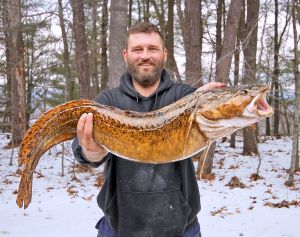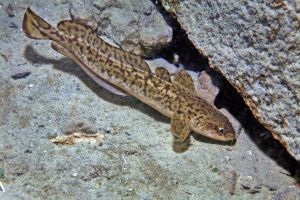Cusk Fishing in NH
Best Baits and Methods for Catching Cusk in New Hampshire
Ice Fishing for Cusk
 New Hampshire is blessed with cold, deep, natural lakes that have sustained the native fauna in their deep basins since the retreat of the glacial ice sheet ten to twenty thousand years ago. The cusk is one of our native fishes, and flourishes right under the noses, or "feet", of many anglers who have never seen or angled for them.
New Hampshire is blessed with cold, deep, natural lakes that have sustained the native fauna in their deep basins since the retreat of the glacial ice sheet ten to twenty thousand years ago. The cusk is one of our native fishes, and flourishes right under the noses, or "feet", of many anglers who have never seen or angled for them.
Although cusk are occasionally caught during the open water season, ice-in on our large lakes marks the beginning of the traditional season for the pursuit of cusk. It is this time of year, of cold water temperatures, that cusk become voracious predators on a variety of invertebrates (e.g. crayfish) and other fish.
With their summer lethargy behind them, cusk move inshore during late fall and concentrations can be found in near-shore areas where water depths of 30 feet or less are found. Cusk are creatures of the night and can be found on soft-bottomed areas of the lakes, although rocky cobble bottoms are most frequented by cusk, in search of their favorite prey - crayfish.
The usual method employed by anglers is night fishing with cusk lines. A cusk fishing line is defined as a device for storing line, which is not free running and will hold enough Dacron or squidding line to reach bottom in the area chosen to fish. The angler's name and address must be plainly marked on each device. On the business end, you must have a sinker or weight one ounce or heavier (if using 1 oz. sinker, must be lead-free), and not more than six inches above the single, baited hook. Each angler is allowed six of these cusk devices and the specifiied angler must check them by visually inspecting the bait end of the line, at least once every 24-hour period. Sound confusing? It isn't really, considering this method is a "throwback" to earlier times when limits and methods for angling did not exist. Furthermore, the angler is prohibited from "jigging" or "bobbing" this cusk line in order to attract fish. Only cusk may be taken with these lines. All other species must be released by cutting the line, near the mouth, while the fish remains in the water.
Anglers who fish during the day, with tip-ups, usually save the remainder of their bait (either minnows or smelt) and use them, dead or alive, for their cusk lines (live bait has more attraction power). The cheapest, moderate sized minnow (3-4 inches long) is fine for cusk, but larger baits will generally keep small cusk off your line and allow larger cusk the opportunity to find and consume your bait. If you have the opportunity, check your cusk lines frequently in the twenty-four hour period. Loss of bait is easy to detect when you check more often and your cusk fishing nights will be more productive with fresh bait on your set.
As you can see, this method of fishing leaves a bit to be desired in terms of finesse and sheer excitement. I have found a way to angle for cusk that can be every bit as exciting as jigging for lake trout. Actually I discovered that cusk will hit baited jigs quite readily and the larger-sized fish certainly will stretch the muscles in your arms when caught in this manner. While jigging for lake trout, I have caught the occasional cusk either early in the morning or late in the afternoon, near dusk. Dark, overcast days will be the most productive for cusk. I've "extended" my fishing day for a couple hours after dusk and have had fast action on cusk in the same area I have taken lake trout during the day. My "chum" piles, deposited on bottom for lake trout, were readily located and consumed by cusk at the onset of darkness. Chum for cusk isn't fancy; the remains of a cut-up sucker, chopped to small pieces, sometimes mixed with kernel corn, will attract cusk (and the cusk’s favorite prey, crayfish) to your area.
I use my regular wooden jig stick for cusk, although many anglers now use 3 to 4 foot fiberglass or graphite rods with spinning reels. I would recommend a rugged, abrasion resistant monofilament or braided line (e.g. Fireline) of 10 to 14 pound test because cusk have rows of small teeth that will eventually weaken your line. Check your lines often when catching cusk and keep a sharp hook point. Cobble areas quickly dull hooks, if jigs are fished over them and allowed to "hook" onto rocks.
I use my standard lake trout jigs for cusk, including Swedish Pimples (size 6 or 7), 3/4 to 1 ounce lead-head bucktail jigs, and Crippled Herring jigs, in an assortment of colors and finishes. Phosphorescent jigs, which emit light, can be highly effective. All of these jigs tipped with a shiner or cut bait must have a single hook/one hook point (no treble), by law, while fishing through the ice.
My choice of bait for winter jigging is the common white sucker. They are readily available in New Hampshire Lakes Region bait stores. I prefer the larger sizes, 14 to 16 inches, and utilize the entire fish as chum when my fishing day (or night) is complete. After euthanizing the sucker, scale the sides and proceed to fillet the fish. Cutting strips of bait 3/4 of an inch wide from the dorsal to ventral sides of the fillet will give you a tapered bait that will last through several catches. I insert my hook point into the flesh side and out the skin side. Minnows or shiners may be hooked through the head with the point exposed on the side.
 After dropping your jig on bottom, slowly lift the lure and bait up to 6 to 10 inches and let it drop to bottom again (remember, this is for your “jigging” rod – the six cusk “set” lines can not be jigged). If you keep slack out of your line you will have a good "feel" for what your bait is doing and the type of bottom you are fishing. Cusk will normally grab your bait as it sits motionless on bottom, just before you begin your upward stroke. When weight is felt on the line, give a strong upward thrust with your stick or rod and keep the fish heading towards your hole. Cusk are strong and battle well, especially if you have hooked one that is in excess of three pounds. Try not to give the fish slack line because the weight of the jig or sinker will help dislodge the hook from the mouth. While there is no size or creel limit on cusk, jigging allows you to catch and release more effectively, which is encouraged if you have already kept enough cusk to provide a meal.
After dropping your jig on bottom, slowly lift the lure and bait up to 6 to 10 inches and let it drop to bottom again (remember, this is for your “jigging” rod – the six cusk “set” lines can not be jigged). If you keep slack out of your line you will have a good "feel" for what your bait is doing and the type of bottom you are fishing. Cusk will normally grab your bait as it sits motionless on bottom, just before you begin your upward stroke. When weight is felt on the line, give a strong upward thrust with your stick or rod and keep the fish heading towards your hole. Cusk are strong and battle well, especially if you have hooked one that is in excess of three pounds. Try not to give the fish slack line because the weight of the jig or sinker will help dislodge the hook from the mouth. While there is no size or creel limit on cusk, jigging allows you to catch and release more effectively, which is encouraged if you have already kept enough cusk to provide a meal.
Sand bars and cobble bottoms near islands and brook mouths are excellent areas to explore for cusk. Off shore "humps" that have 30 to 40 feet of water on the ridge, that are adjacent to deep water basins are excellent areas to locate foraging cusk. Cusk often travel in concentrations and, at times, action can be fast and furious.
In terms of overall quantity and quality, I would rate Second Connecticut and Winnipesaukee lakes as my top choices for cusk. The current state record for cusk is 11 pounds, 2.2 ounces caught in Sunapee Lake in 1984. Cusk of 18 pounds or greater have been reported in Maine, Minnesota and Michigan. The average New Hampshire cusk is 1.5 to 3 pounds in size, with 4-6 pound fish considered “nice” specimens. However, cusk in the 7-9 pound range are taken annually. Many cusk just ounces shy of a new state record have been entered into the Trophy Fish Program in the past several years.
Many consider cusk the finest freshwater fish to consume. It is delicious fried or baked and has firm white meat with a delicate flavor. The "old timers" will offer that there is no better fish to create hearty winter chowder.
Explore and enjoy our New Hampshire lakes this winter. Tending your cusk lines for a couple of hours after sunset can be a rich experience. Listen to the lake "making ice" as water freezes and expands to produce a myriad of sounds. Above all, you will relish the time spent fishing for this true "New Hampshire Native."



